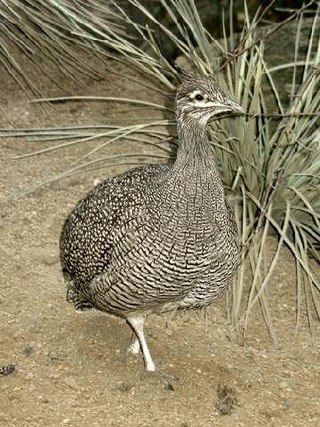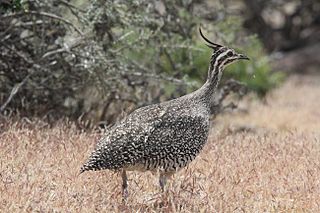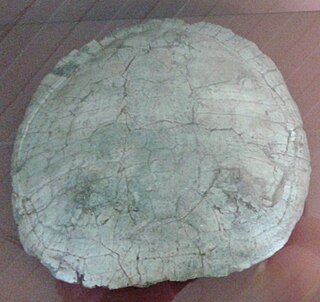
Caenorhabditis elegans is a free-living transparent nematode about 1 mm in length that lives in temperate soil environments. It is the type species of its genus. The name is a blend of the Greek caeno- (recent), rhabditis (rod-like) and Latin elegans (elegant). In 1900, Maupas initially named it Rhabditides elegans. Osche placed it in the subgenus Caenorhabditis in 1952, and in 1955, Dougherty raised Caenorhabditis to the status of genus.

The red-eared slider or red-eared terrapin is a subspecies of the pond slider, a semiaquatic turtle belonging to the family Emydidae. It is the most popular pet turtle in the United States, is also popular as a pet across the rest of the world, and is the most invasive turtle. It is the most commonly traded turtle in the world.

Howard Robert Horvitz ForMemRS NAS AAA&S APS NAM is an American biologist best known for his research on the nematode worm Caenorhabditis elegans, for which he was awarded the 2002 Nobel Prize in Physiology or Medicine, together with Sydney Brenner and John E. Sulston, whose "seminal discoveries concerning the genetic regulation of organ development and programmed cell death" were "important for medical research and have shed new light on the pathogenesis of many diseases".

Sir John Edward Sulston was a British biologist and academic who won the Nobel Prize in Physiology or Medicine for his work on the cell lineage and genome of the worm Caenorhabditis elegans in 2002 with his colleagues Sydney Brenner and Robert Horvitz at the MRC Laboratory of Molecular Biology. He was a leader in human genome research and Chair of the Institute for Science, Ethics and Innovation at the University of Manchester. Sulston was in favour of science in the public interest, such as free public access of scientific information and against the patenting of genes and the privatisation of genetic technologies.

The ring-tailed vontsira, locally still known as the ring-tailed mongoose is a euplerid in the subfamily Galidiinae, a carnivoran native to Madagascar. It is the only species in the genus Galidia.

The pond slider is a species of common, medium-sized, semiaquatic turtle. Three subspecies are described, the most recognizable of which is the red-eared slider, which is popular in the pet trade and has been introduced to other parts of the world by people releasing it to the wild. Hatchling and juvenile pond sliders have a green upper shell (carapace), yellow bottom shell (plastron), and green and yellow stripes and markings on their skin. These patterns and colors in the skin and shell fade with age until the carapace is a muted olive green to brown and the plastron is a dull yellow or darker. Some sliders become almost black with few visible markings. The carapace is oval with a bit of rounding and a central crest with knobs, but these features soften and fade with age, adults being smoother and flatter. For determining an adult slider's sex, males typically have much longer front claws than adult females, while females usually have shorter, more slender tails than males. Their lifespans range from 20 to 50 years.

The elegant crested tinamou or martineta tinamou is a medium-sized tinamou that can be found in southern Chile and Argentina in Shrubland. The bird has an omnivorous diet. This species is terrestrial due to their poor flying ability.

The elegant water shrew is a species of mammal in the subfamily Soricinae of the family Soricidae. It is the only species within the genus Nectogale. It lives in Sikkim and China.

Eudromia is a genus of birds in the tinamou family. This genus comprises two crested members of this South American family.

Habrotrocha rosa is a bdelloid rotifer that has been found in leaf litter, soil, and moss in Europe and New Zealand and also in North America within the pitchers of Sarracenia purpurea, the purple pitcher plant. It is one of many species that make up the inquiline community that thrives within the water-retaining pitcher-shaped leaves of S. purpurea.
Chaetonotus elegans is a species of gastrotrichs in the genus Chaetonotus. It is found in freshwater of Europe.

Nektarios N. Tavernarakis is a Greek bioscientist, who studies Ageing, Cell death, and Neurodegeneration. He is currently Distinguished Professor of Molecular Systems Biology at the Medical School of the University of Crete, and the Chairman of the Board of Directors at the Foundation for Research and Technology, in Heraklion, Crete, Greece. He is also the founder and first Director of the Graduate Program in Bioinformatics of the University of Crete Medical School, and has served as Director of the Institute of Molecular Biology and Biotechnology, where he is heading the Neurogenetics and Ageing laboratory. He was elected Vice President of the European Research Council (ERC) in 2020, and Chairman of the European Institute of Innovation and Technology (EIT) Governing Board and Executive Committee in 2022.
Cercinthus elegans is a species of bugs in the tribe Coreini. It is found in the Canary Islands.
Eridolius elegans is a species of wasp. It is found in Europe.
Syntretus elegans is a species of parasitic wasps of adult bumblebees. It is found in Europe.

Bauruemys is an extinct genus of turtles in the family Podocnemididae.
Nemeritis elegans is a species of ichneumon wasps found in Europe.
Neophyllobius elegans is a species of mites found in Italy.
Pardosa elegans is a species of wolf spiders found in Russia.











